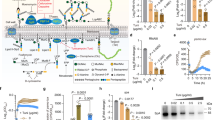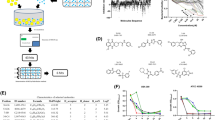Abstract
The world is heading toward a dangerous post-antibiotic era where antibiotics fail to treat infections. Staphylococcus aureus is the leading cause of healthcare-associated infections worldwide, and an ever-increasing percentage of them are methicillin-resistant (MRSA). New strategies are urgently needed to combat this pathogen. Wall teichoic acids (WTA) in S. aureus are polyribitol phosphate polymers that play important roles in virulence and resistance to β-lactam antibiotics. Here, we describe a high-throughput whole-cell screening platform for inhibitors targeting WTA biosynthesis. This platform takes advantage of the unique dispensability patterns of genes encoding WTA biosynthesis. We further describe follow-up dose-response assays to identify WTA inhibitors among the primary bioactives. WTA inhibitors offer an exciting opportunity for the development of novel antibacterial leads of unique mechanism in the fight against drug-resistant staphylococcal infections.
Access this chapter
Tax calculation will be finalised at checkout
Purchases are for personal use only
Similar content being viewed by others
References
WHO (2014) Antimicrobial resistance: global report on surveillance. World Health Organization reports. World Health Organization
Li XZ, Plesiat P, Nikaido H (2015) The challenge of efflux-mediated antibiotic resistance in gram-negative bacteria. Clin Microbiol Rev 28(2):337–418. https://doi.org/10.1128/CMR.00117-14
Starosta AL, Lassak J, Jung K, Wilson DN (2014) The bacterial translation stress response. FEMS Microbiol Rev 38(6):1172–1201. https://doi.org/10.1111/1574-6976.12083
Marrakchi M, Liu X, Andreescu S (2014) Oxidative stress and antibiotic resistance in bacterial pathogens: state of the art, methodologies, and future trends. Adv Exp Med Biol 806:483–498. https://doi.org/10.1007/978-3-319-06068-2_23
de la Fuente-Nunez C, Reffuveille F, Fernandez L, Hancock RE (2013) Bacterial biofilm development as a multicellular adaptation: antibiotic resistance and new therapeutic strategies. Curr Opin Microbiol 16(5):580–589. https://doi.org/10.1016/j.mib.2013.06.013
WHO (2017) Prioritization of pathogens to guide discovery, research and development of new antibiotics for drug-resistant bacterial infections including tuberculosis. World Health Organization, Geneva
Tong SY, Davis JS, Eichenberger E, Holland TL, Fowler VG Jr (2015) Staphylococcus aureus infections: epidemiology, pathophysiology, clinical manifestations, and management. Clin Microbiol Rev 28(3):603–661. https://doi.org/10.1128/CMR.00134-14
The Canadian Cystic Fibrosis Registry 2013 Annual Report (2015). Cystic Fibrosis Canada
Sewell EW, Brown ED (2014) Taking aim at wall teichoic acid synthesis: new biology and new leads for antibiotics. J Antibiot 67(1):43–51. https://doi.org/10.1038/ja.2013.100
D'Elia MA, Henderson JA, Beveridge TJ, Heinrichs DE, Brown ED (2009) The N-acetylmannosamine transferase catalyzes the first committed step of teichoic acid assembly in Bacillus subtilis and Staphylococcus aureus. J Bacteriol 191(12):4030–4034. https://doi.org/10.1128/JB.00611-08
D'Elia MA, Millar KE, Beveridge TJ, Brown ED (2006) Wall teichoic acid polymers are dispensable for cell viability in Bacillus subtilis. J Bacteriol 188(23):8313–8316. https://doi.org/10.1128/JB.01336-06
D'Elia MA, Pereira MP, Chung YS, Zhao W, Chau A, Kenney TJ, Sulavik MC, Black TA, Brown ED (2006) Lesions in teichoic acid biosynthesis in Staphylococcus aureus lead to a lethal gain of function in the otherwise dispensable pathway. J Bacteriol 188(12):4183–4189. https://doi.org/10.1128/JB.00197-06
Campbell J, Singh AK, Santa Maria JP Jr, Kim Y, Brown S, Swoboda JG, Mylonakis E, Wilkinson BJ, Walker S (2011) Synthetic lethal compound combinations reveal a fundamental connection between wall teichoic acid and peptidoglycan biosyntheses in Staphylococcus aureus. ACS Chem Biol 6(1):106–116. https://doi.org/10.1021/cb100269f
Weidenmaier C, Kokai-Kun JF, Kristian SA, Chanturiya T, Kalbacher H, Gross M, Nicholson G, Neumeister B, Mond JJ, Peschel A (2004) Role of teichoic acids in Staphylococcus aureus nasal colonization, a major risk factor in nosocomial infections. Nat Med 10(3):243–245. https://doi.org/10.1038/nm991
Farha MA, Leung A, Sewell EW, D'Elia MA, Allison SE, Ejim L, Pereira PM, Pinho MG, Wright GD, Brown ED (2013) Inhibition of WTA synthesis blocks the cooperative action of PBPs and sensitizes MRSA to beta-lactams. ACS Chem Biol 8(1):226–233. https://doi.org/10.1021/cb300413m
Campbell J, Singh AK, Swoboda JG, Gilmore MS, Wilkinson BJ, Walker S (2012) An antibiotic that inhibits a late step in wall teichoic acid biosynthesis induces the cell wall stress stimulon in Staphylococcus aureus. Antimicrob Agents Chemother 56(4):1810–1820. https://doi.org/10.1128/AAC.05938-11
Wang H, Gill CJ, Lee SH, Mann P, Zuck P, Meredith TC, Murgolo N, She X, Kales S, Liang L, Liu J, Wu J, Santa Maria J, Su J, Pan J, Hailey J, McGuinness D, Tan CM, Flattery A, Walker S, Black T, Roemer T (2013) Discovery of wall teichoic acid inhibitors as potential anti-MRSA beta-lactam combination agents. Chem Biol 20(2):272–284. https://doi.org/10.1016/j.chembiol.2012.11.013
Zlitni S, Blanchard JE, Brown ED (2009) High-throughput screening of model bacteria. Methods Mol Biol 486:13–27. https://doi.org/10.1007/978-1-60327-545-3_2
Farha MA, Czarny TL, Myers CL, Worrall LJ, French S, Conrady DG, Wang Y, Oldfield E, Strynadka NC, Brown ED (2015) Antagonism screen for inhibitors of bacterial cell wall biogenesis uncovers an inhibitor of undecaprenyl diphosphate synthase. Proc Natl Acad Sci U S A 112(35):11048–11053. https://doi.org/10.1073/pnas.1511751112
Czarny TL, Brown ED (2016) A small-molecule screening platform for the discovery of inhibitors of undecaprenyl diphosphate synthase. ACS Infect Dis 2(7):489–499. https://doi.org/10.1021/acsinfecdis.6b00044
Lee K, Campbell J, Swoboda JG, Cuny GD, Walker S (2010) Development of improved inhibitors of wall teichoic acid biosynthesis with potent activity against Staphylococcus aureus. Bioorg Med Chem Lett 20(5):1767–1770. https://doi.org/10.1016/j.bmcl.2010.01.036
CLSI (2012) Methods for dilution antimicrobial susceptibility tests for bacteria that grow aerobically; approved standard—Ninth Edition, CLSI document M07-A9. Clinical and Laboratory Standards Institute, Wayne, PA
Zhang JH, Chung TD, Oldenburg KR (1999) A simple statistical parameter for use in evaluation and validation of high throughput screening assays. J Biomol Screen 4(2):67–73. https://doi.org/10.1177/108705719900400206
Acknowledgments
The authors would like to thank Dr. Maya Farha for her critical reading of the manuscript. Wall teichoic acid related research in the authors’ laboratory was supported by grants from the Canadian Institutes of Health Research and from the Canadian glycomics network (GlycoNet) and a Tier I Canada Research Chair award to E.D.B. O.M.E. was supported by a Michael G. DeGroote Fellowship Award in Basic Biomedical Science.
Author information
Authors and Affiliations
Corresponding author
Editor information
Editors and Affiliations
Rights and permissions
Copyright information
© 2019 Springer Science+Business Media, LLC, part of Springer Nature
About this protocol
Cite this protocol
El-Halfawy, O.M., Brown, E.D. (2019). High-Throughput Screening for Inhibitors of Wall Teichoic Acid Biosynthesis in Staphylococcus aureus. In: Brockhausen, I. (eds) Bacterial Polysaccharides. Methods in Molecular Biology, vol 1954. Humana Press, New York, NY. https://doi.org/10.1007/978-1-4939-9154-9_23
Download citation
DOI: https://doi.org/10.1007/978-1-4939-9154-9_23
Published:
Publisher Name: Humana Press, New York, NY
Print ISBN: 978-1-4939-9153-2
Online ISBN: 978-1-4939-9154-9
eBook Packages: Springer Protocols




